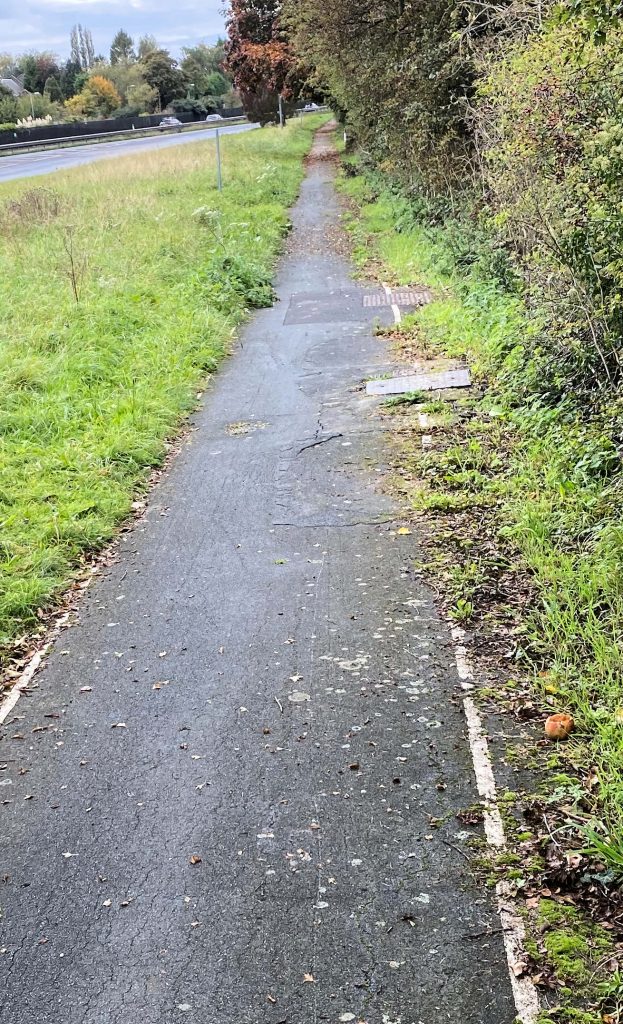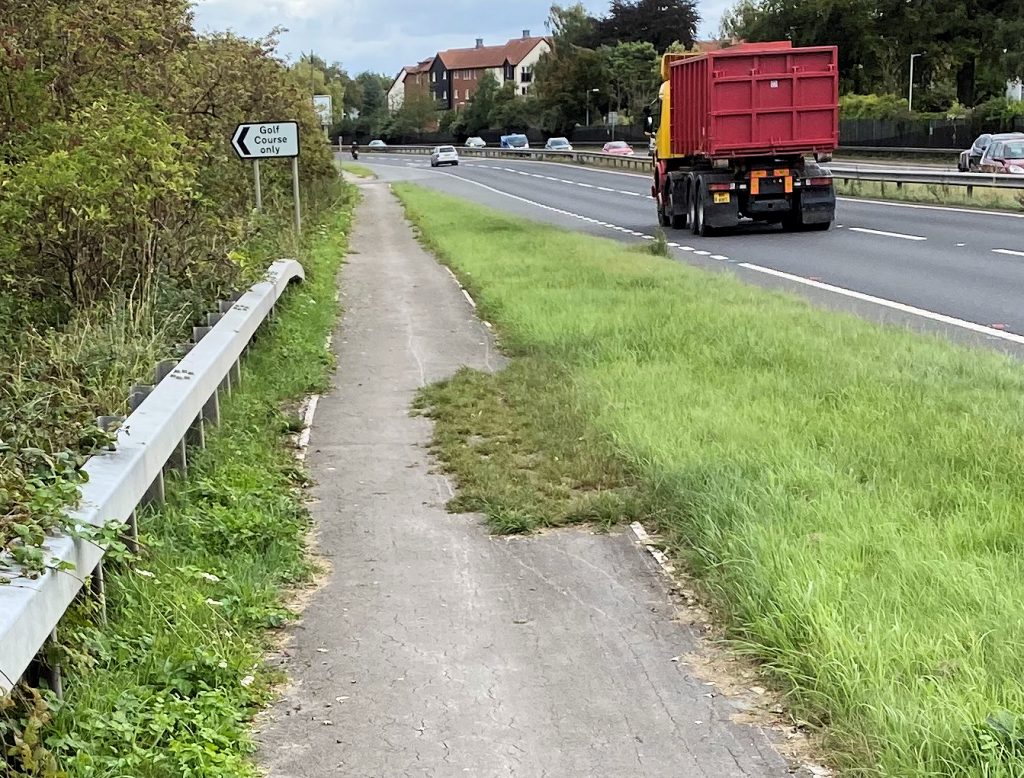Deaths and test results
There have been no further hospital deaths reported today.
The number of new cases announced today is 46 (FOURTY SIX). That is the lowest, single day, total announced this week.
The cumulative total number of cases is now 1884
The number of new cases in the last 7 days – expressed pro rate to 100,000 of population – is 201.32. This is higher than the regional and national average.
The worst affected neighbourhood is still Heslington, Fulford and the University. There have been 61 confirmed cases there in the last week.
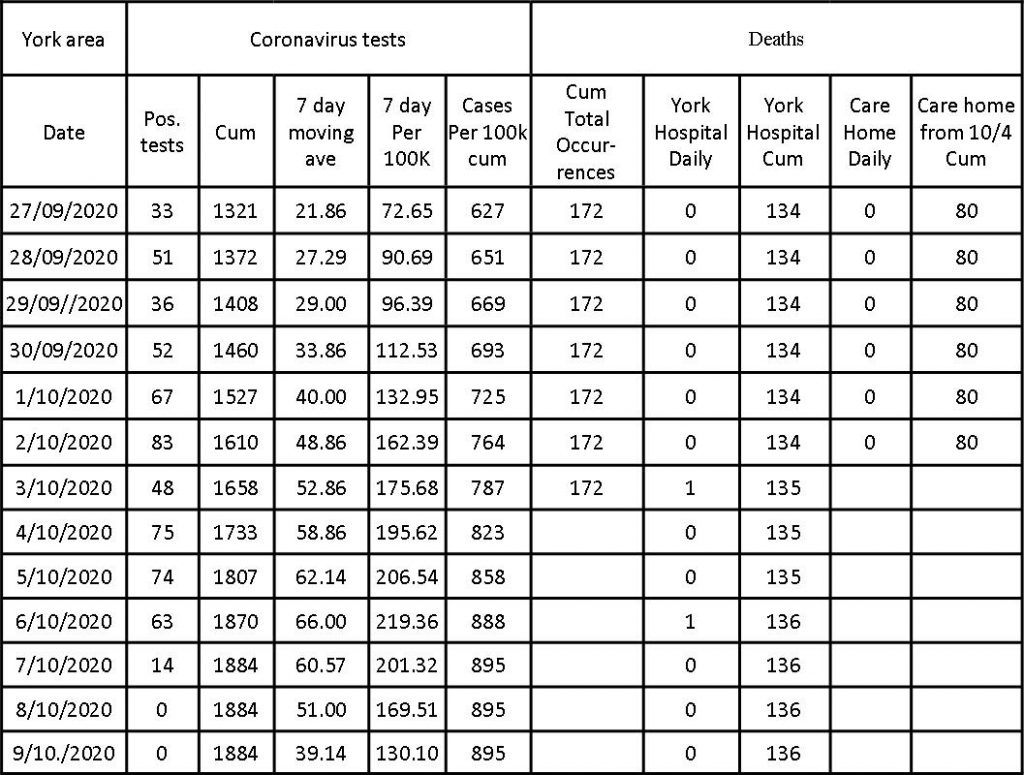
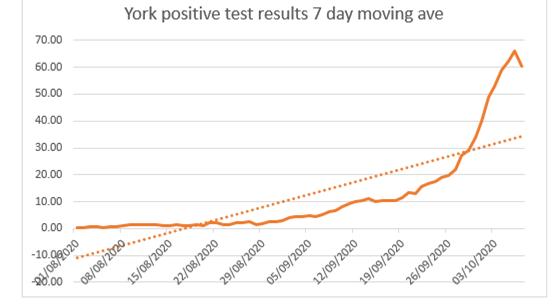
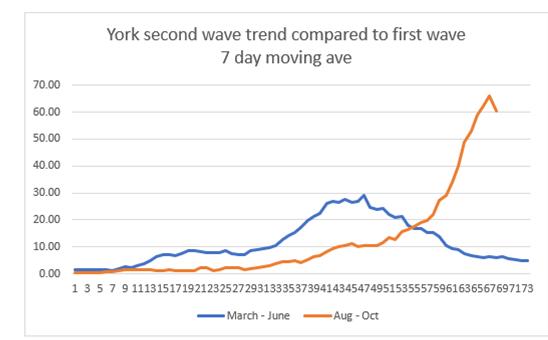
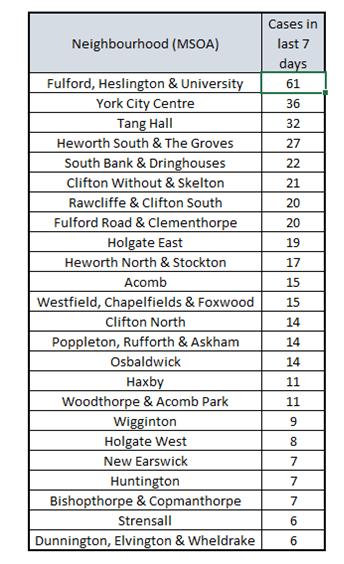
We have looked at how the number of tests being carried out may be influencing the reported number of cases. The governments figures (click) only cover the period up to 30th September and cover pillar 2 tests only. . They don’t yet cover the period after the new Heslington test centre had ramped up to full capacity. The figure do however show that the recent surge in cases is not solely down to increased testing.
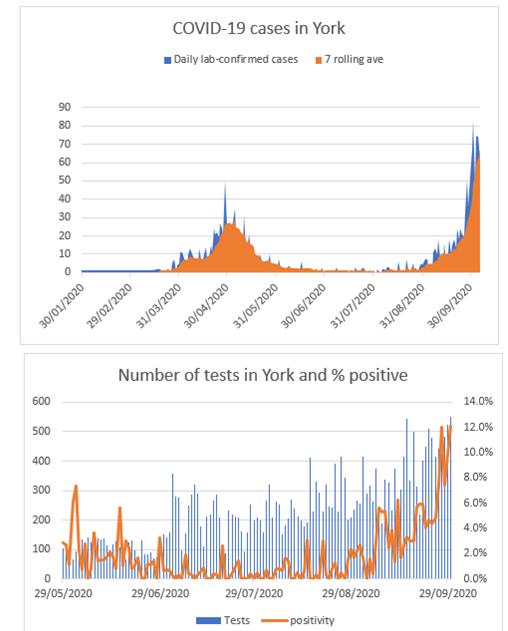
York Council commentary
The Council has updated its “open data” commentary on the pandemic. It is reproduced below
People with Covid Symptoms
• NHS Pathways /111 triages – as at 5.10.20 there had been 406 total covid triages in the CYC area in the last 7 days. The numbers have just started to fall in the last few days after a very steep rise over the previous 2-3 weeks with a peak of 653 triages in the 7 day period to 20.9.20.
• As at 7.10.20, the Covid Symptom App estimates 733.2 per 100,000 in York with symptomatic covid (responses from a sample of 5,352 people). The peak estimated rate was 1,029.4 on 29.9.20.
Diagnosed cases (Pillar 1&2 combined)
• As at 8.10.20 York has had 1,838 cases, a rate of 872.7 per 100,000 of population. The rate in York is above the national average (853.9) but below the regional average (1193.4) average.
• The PHE ‘Exceedance’ rating compares the no. of new cases over a 14 day period with the previous 6 weeks and provides a RAG rating to indicate if the previously observed trend in the no. of new cases is worsening. The latest rating for York (5.10.20) is Amber
• The provisional rate for the last seven days of new Covid cases per 100,000 of population in York as at 6.10.20 is 203.69. The provisional national and regional averages are 124.68 and 220.24 respectively.
• The latest local “validated” 7 day rate at 2.10.20 was 161. The national and regional averages at this date were 109.3 and 190.1 respectively.
• As at 5.10.20, the latest 7 day positivity rate in York (Pillar 2 only) was 11.57% (447 positives out of 3,864 tests). The national and regional averages are 7.1% and 10.7% respectively. The number of Pillar 2 tests being carried out in York is increasing.
• The Fulford, Heslington and University MSOA is in the top 5% in the Yorkshire and Humber Region for new cases per 100,000 in the seven day period up to 2.10.20. Other MSOAs in the region (e.g. Leeds and Bradford) which contain university premises within their boundaries are also on this list.
Contact Tracing
• Since 28.5.20 a total of 1,003 laboratory confirmed CYC Covid cases have been uploaded into the NHS Test and Trace system and 703 of the cases have been engaged. 2,609 ‘contacts’ have been identified and 1,699 of these have been traced.
Deaths
The two sources about deaths from Covid-19 at LA level are ONS data and local registrar data. They are derived from the same source (civil registration data). ONS data is more comprehensive as it includes deaths of York residents which have occurred and been registered outside York. Local registrar data is useful as it provides a breakdown by age and gender. The most recently available data is summarised below:
• ONS weekly data: For deaths occurring up to 25th September 2020 and registered up to 3rd October 2020, 172 deaths were recorded as having occurred for CYC residents (83 in hospital, 77 in care homes, 9 at home and 3 in a hospice. The number of deaths per 100,000 of population in York is 81.66 which is lower than the national average of 89.10. The most recent death reported for a York resident was in week 38 (12 to 18 September).
• ‘Excess’ deaths (ONS). In week 39 (19 Sept to 25 Sept), 21 deaths occurred in York, which is 8 fewer than the average weekly number for 2014-18. Over the last 18 weeks the total number of deaths in York has been 53 fewer than the average for the equivalent weeks in 2014-18.
• Local Registrar data: In the weekly data received on 5.10.20 (for deaths occurring up to 30.9.20), a cumulative total of 163 deaths of CYC residents where COVID-19 was mentioned (confirmed or suspected) on the death certificate, have been registered. The average age of the people who died was 82.5, with an age range of 53-104. The age profile of those dying in York is slightly older than the national average. 87 of the 163 were male (53.4%), slightly less than the national average (55.1%). 81 of the deaths occurred in hospital and 82 were community deaths (e.g. at home or in a care home or hospice). 71 people (43.6%) died in nursing /care homes (the national average is 29.43%). In addition 13 people (8%) who normally resided in nursing/care homes in the CYC area, died in hospital.
Data on deaths occurring in hospital are shown below. Deaths are initially reported for York NHS Foundation Trust which includes Scarborough Hospital and the further breakdown by site can be delayed. From local registrar data, 58.1% of COVID-19 deaths occurring at York Hospital have been CYC residents. (NB NHS Trusts record deaths following a positive covid-19 test (within 28 days) whereas ONS record deaths where covid-19 in mentioned on the death certificate so the totals are not the same).
• Deaths at York Hospital: As at 8.10.20, 136 deaths of people who had tested positive for COVID-19 and were being cared for at York Hospital have been reported. 216 deaths have been reported by the wider York NHS Trust.

